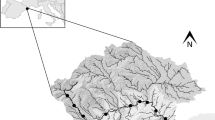Abstract
Boundary layer flow characteristics and sediment permeability control pathways and magnitude of material exchange in the surface layer of aquatic sediments. In fine-grained cohesive beds, bottom currents and sediment microtopography shape the diffusive boundary layer and locally produce areas where the interfacial solute fluxes are increased or reduced. Where sediment permeabilities exceed 10−12 m2, advective pore water flows driven by boundary flow–topography interaction dominate the sediment–water exchange of matter, with transport rates that exceed those of molecular diffusion by two orders of magnitude and more. The curved paths of the advective pore flows through the surface layers of such sandy beds generate complex three-dimensional biogeochemical patterns with extreme spatial and temporal variability ranging from millimeters to decimeters and seconds to seasons. High filtration rates, a bacterial community firmly attached to the mineral grains, rapidly changing biogeochemical zonations and winnowing of the sediment surface layers by frequent resuspension convert these beds into effective biocatalytical filter systems.
Similar content being viewed by others
References
Aller, R., 1994. Bioturbation and remineralization of sedimentary organic matter: effects of redox oscillation. Chem. Geol. 114: 331-345.
Aller, R. C., 1982. The effects of macrobenthos on chemical properties of marine sediment and overlying water. In McCall, P. L. & M. J. S. Tevesz (eds),Animal-Sediment Relations. Plenum Press, New York: 53-96.
Andersen, F. & W. Helder, 1987. Comparison of oxygen microgradients, oxygen flux rates and electron transport system activity in coastal marine sediments. Mar. Ecol. Progr. Ser.37: 59-264.
Berner, R. A., 1976. The benthic boundary layer from the viewpoint of a geochemist. In McCave, I. N. (ed.), The Benthic Boundary Layer. Plenum Press, New York: 33-55.
Berner, R. A., 1980. Early Diagenesis-A Theoretical Approach. Princeton University Press, Princeton, NJ.
Berninger, U. G. & M. Huettel, 1997. Impact of flow on oxygen dynamics in photosynthetically active sediments. Aquat. Microbial Ecol. 12(3): 291-302.
Canfield, D. E., B. B. Jørgensen, H. Fossing, R. Glud, J. Gundersen, N. B. Ramsing, B. Thamdrup, J. W. Hansen, L. P. Nielsen & P. O. J. Hall, 1993. Pathways of organic carbon oxidation in three continental margin sediments. Mar. Geol. 113: 27-40.
Golosov, S. D. & N. V. Ignatieva, 1999. Hydrothermodynamic features of mass exchange across the sediment-water interface in shallow lakes. Hydrobiologia 409: 153-157.
Huettel, M. & G. Gust, 1992. Impact of bioroughness on interfacial solute exchange in permeable sediments. Mar. Ecol. Progr. Ser. 89(23): 253-267.
Huettel, M. & A. Rusch, 2000. Transport and degradation of phytoplankton in permeable sediment. Limnol. Oceanogr. 45(3): 534-549.
Huettel, M., W. Ziebis & S. Forster, 1996. Flow-induced uptake of particulate matter in permeable sediments. Limnol. Oceanogr. 41(2): 309-322.
Huettel, M., W. Ziebis, S. Forster & G. W. Luther, 1998. Advective transport affecting metal and nutrient distributions and interfacial fluxes in permeable sediments. Geochim. Cosmochim. Acta 62(4): 613-631.
Ignatieva, N. V., 1996. Distribution and release of sedimentary phosphorus in Lake Ladoga. Hydrobiologia 322(13): 129-136.
Jørgensen, B. B., 1994. Diffusion processes and boundary layers in microbial mats. In Stal, L. J. & P. Caumette (eds), Microbial Mats, Vol. 35, Springer, Berlin Heidelberg. NATO ASI Series: 243-253.
Jørgensen, B. B. & D. J. Des Marais, 1990. The diffusive boundary layer of sediments: oxygen microgradients over a microbial mat. Limnol. Oceanogr. 35(6): 1343-1355.
Li, M. Z. & C. L. Amos, 1999. Field observations of bedforms and sediment transport thresholds of fine sand under combined waves and currents. Mar. Geol. 158(1-4): 147-160.
Lohse, L., E. H. G. Epping, W. Helder & W. Vanraaphorst, 1996. Oxygen pore water profiles in continental shelf sediments of the North Sea - turbulent versus molecular diffusion. Mar. Ecol. Progr. Ser. 145(1-3): 63-75.
Migne, A. & D. Davoult, 1998. Macrobenthic metabolism as carbon and nitrogen fluxes in a coastal area exposed to strong tidal currents (Dover Strait, Eastern English Channel). Hydrobiologia 376: 307-315.
Pilditch, C. A., C. W. Emerson & J. Grant, 1998. Effect of scallop shells and sediment grain size on phytoplankton flux to the bed. Cont. Shelf Res. 17(15): 1869-1885.
Røy, H., M. Huttel & B. B. Jorgensen, 2002. The role of smallscale sediment topography for oxygen flux across the diffusive boundary layer. Limnol. Oceanogr. 47(3): 837-847.
Rusch, A., S. Forster & M. Huettel, 2001. Bacteria, diatoms and detritus in an intertidal sandflat subject to advective transport across the water-sediment interface. Biogeochemistry 55(1): 1-27.
Savant, S. A., D. D. Reible & L. J. Thibodeaux, 1987. Convective transport within stable river sediments. Water Resour. Res. 23: 1763-1768.
Shum, K. T. & B. Sundby, 1996. Organic matter processing in continental shelf sediments - the subtidal pump revisited. Mar. Chem. 53(12): 81-87.
Thibodeaux, L. J. & J. D. Boyle, 1987. Bedform-generated convective transport in bottom sediment. Nature 325: 341-343.
Vanrees, K. C. J., K. R. Reddy & P. S. C. Rao, 1996. Influence of benthic organisms on solute transport in lake sediments. Hydrobiologia 317(1): 31-40.
Vaughn, C. C. & C. C. Hakenkamp, 2001. The functional role of burrowing bivalves in freshwater ecosystems [Review]. Freshwater Biol. 46(11): 1431-1446.
Villar, C., L de Cabo, P. Vaithiyanathan & C. Bonetto, 1999. Pore water N and P concentration in a floodplain marsh of the Lower Parana River. Hydrobiologia 392(1): 65-71.
Wainright, S. C., C. A. Couch & J. L. Meyer, 1992. Fluxes of bacteria and organic matter into a Blackwater river from river sediments and floodplain soils. Freshwater Biol. 28(1): 37-48
Author information
Authors and Affiliations
Rights and permissions
About this article
Cite this article
Huettel, M., Røy, H., Precht, E. et al. Hydrodynamical impact on biogeochemical processes in aquatic sediments. Hydrobiologia 494, 231–236 (2003). https://doi.org/10.1023/A:1025426601773
Issue Date:
DOI: https://doi.org/10.1023/A:1025426601773




